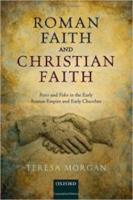
OUP (2015) h/b 626pp £95 (ISBN 9780198724148)
St. Augustine of Hippo (AD 354-430) divided fides (‘faith’, pistis in Greek) into fides quae creditur and fides qua creditur, i.e. the faith which is believed—all those propositions contained in the Nicene Creed, the 39 articles and so on—and the faith by which it is believed, i.e. what goes on in hearts and minds. In her superb analysis encompassing ancient language, culture and society, M. (professor of Graeco-Roman history at Oxford) argues that it was not always so.
She bases her work on the hypothesis that a new religion would not adopt standard pagan words like fides and pistis only to use them in senses bewildering to hoi polloi. To test it, she subjects those two crucial terms to a rigorous, closely-argued, wide-ranging analysis across everyday usage in the Graeco-Roman worlds of the first centuries BC and AD: personally, among e.g. family members, patrons, clients and friends; professionally among e.g. soldiers, politicians, diplomats, lawyers; and finally in relation to gods (here M. suggests that intra-human fides/pistis functioned best where divine-human fides/pistis was most evident, i.e. when cult and ritual were involved). That done, she then turns to the Septuagint and the New Testament to see what fit, if any, there is between the pagan and Christian understanding of the matter.
Her conclusion is that fides/pistis in the pagan world did not, and could not, mean ‘faith’ in anything like the Augustinian senses, largely for the reason that pagans, lacking an authoritative text, had no means of defining what the content of that faith could possibly be. She finds, then, that the terms in the Graeco-Roman world referred overwhelmingly to a relationship—that of trust, as between a child and its mother. In many cases, including the classical world, that belief was felt to be so ‘foundational’ to a society that it could virtually be taken for granted. Nevertheless, in most Graeco-Roman contexts (especially where lovers were concerned!) one’s beliefs about the trustworthiness of the other party needed to be confirmed, and until they were (by whatever means) the relationship could also be open to fear, suspicion and doubt. M.’s clear, detailed and persuasive analysis of language in context is a model of how it should be done
M. also finds this relational sense of fides/pistis as ‘trust’ rather than ‘faith’ or ‘belief’ at the heart of Jewish and early Christian thought, a conclusion that will be of much interest to theologians. In the Septuagint, M. agrees that the Jewish equivalent of pistis was not nearly as common a feature of Jewish thought as it was of Christian. In Genesis and Exodus, despite human doubts, God was trustworthy, but pistis was manifested largely in the relationship between God and Israel’s leaders, which might, or might not, feed into the community. By the Hellenistic period, however, scripture and tradition made clear that man’s covenant with God was secure, and trust ‘non-negotiable for human beings’.
In Paul’s letters, probably because Christ’s return was thought to be imminent, the emphasis was not on communal human pistis—except in as much as Paul presents himself as the secure witness to the apostolic truth—but overwhelmingly on God’s trustworthiness and the necessity of man putting his complete trust in Him (there was an ethical content to the message affecting one’s whole way of life). Pistis, then, became effectively colonised as a feature solely of divine-human relationships. But if the Christian community was defined as hoi pisteuontes, it was as ‘the trusting’, not as ‘having faith’: the resurrection, scripture, tradition and so on all pointed to the certainty of Paul’s message. M. then discusses the later letters and the attempt to develop the idea of a community articulated around a unique three-way trust between God the father, Christ and man. She suggests that propositional belief, while ‘always implicit in trust relationships’, began to come to the fore only in James (e.g. M. quotes James as saying ‘God is one’) and elsewhere in disputes between Christians, and Christian disputes with outsiders.
The predominant meaning of pistis as socially active ‘trust’ rather than interiorised ‘faith’ emerged equally in the gospels and Acts, though with different emphases. Here doubt, fear and scepticism came more into play, but the message was that this would not prevent access to the kingdom of God. But there was no sense of a Pauline-style community of the trusting, even in Acts where one might have expected it. Further, M. emphasises that the gospels were clear about Christ as the son of God, and that trust in the one implied trust in the other, but Christ’s humanity made it difficult to be propositional about the nature of that trust, given that He was seen at one and the same time as ‘a great teacher, a wonder-worker, a divinely sanctioned saviour and a divinity’. Further chapters then explore the nature of pistis in John and Revelation, pistis as a psychological phenomenon (not explored by the ancients because trust ‘could only be practised socially’); and the idea of a Christian society structured by pistis as its predominant virtue (M. here looks at similarities between Christianity and Isis-worship).
This fine book, whose riches the reviewer has grossly simplified, raises many fascinating questions, in particular the translation of fides/pistis as ‘belief’ and, without careful glossing, as ‘faith’. Of course Christian thought did not stand still, but even so the early church’s understanding of fides/pistis not as a series of internally held beliefs but as a dynamic, community-structuring ‘trust’ tout court stands in striking contrast to current propositional disputes.
Peter Jones
